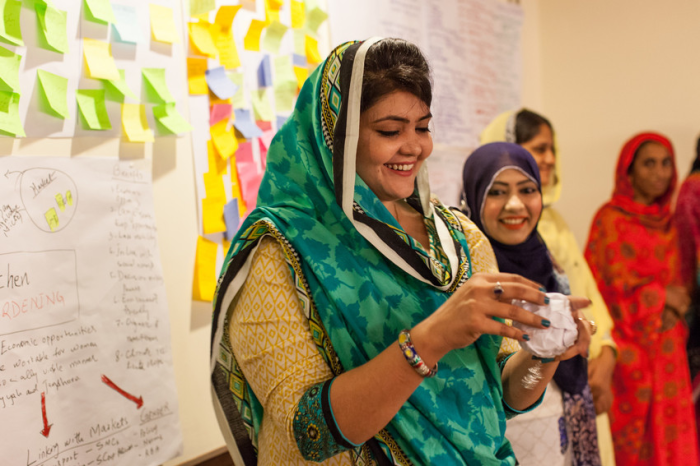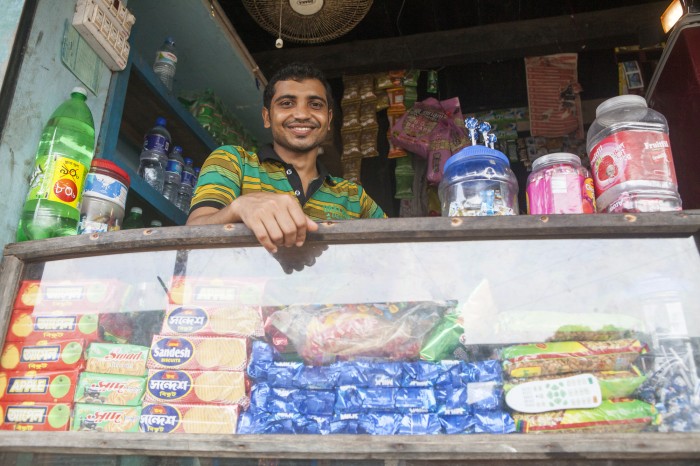Measurement Matters: Analysing Youth Employment and Skills Training
About 200 million people worldwide are unemployed and actively looking for a job. Many of them are young people who are less secure in the labor market as they have less work experience than adults. Youth unemployment is especially a large problem in developing countries, where a large share of the population is young. International organizations try to tackle youth unemployment, among others through providing skills training projects. To get a deeper understanding of how such projects influence youth unemployment, I wrote a paper on the relationship between these two. This blog post will provide the main findings of my paper.
 Pakistani youth attending a workshop. Photo credit: Khaula Jamil / Oxfam Novib.
Pakistani youth attending a workshop. Photo credit: Khaula Jamil / Oxfam Novib.Skill training projects
Skills training projects aim to support young people who just finished or quit formal education, and unemployed, job seeking youth in general. These projects address mismatches between the skills that young people learn at schools and these required by the job market. Projects provide technical or vocational skills to supply youth with the necessary skills matching the demand of the local labor market. Projects also provide soft skills training to increase the likeliness of youth to find a job or start a successful business themselves through increasing skills like autonomy or job interview skills.
Skills training projects seem a logical strategy to tackle youth unemployment and there is a lot of demand for such training projects. However, the available experimental research on the effect of skills training projects on youth employment shows mixed results. Participation in soft skill training projects generally shows no significant increase in and for technical skill training (TVET). The success depends on the local demand of the skills being taught employment (see e.g. Groh et al. (2016), Honorati (2015), Card et al (2011) and Bausch et al. (2017)). Many TVET projects include internships, which could be an explanation for the difference in measured effects compared to soft skill training projects. Internships contribute to the participants’ level of work experience, their network, and possibly even their soft skills, which could therefore be more effective than a regular training only.
Hence, based upon the literature study, skills training projects alone are not always the solution to youth unemployment. Therefore, Oxfam Novib’s youth employment projects are more inclusive, which means that skill training is one of the components of the project. The Empower Youth for Work project, for example, includes both technical and soft skill training and simultaneously aims to influence local employers and create an enabling environment by addressing social norms that hinder young people in finding a job. To measure the impact of these projects, data about the participants is collected before and after the implementation of the project via surveys. These surveys also inform the project about the local demand for skills and specific restrictions faced by participants.
With the baseline data of two of Oxfam Novib’s projects on youth unemployment, active in 7 countries, I made a first assessment of the relationship between skills and employment. Note that this concerns the level of skills in general, before participating in skills training. It is NOT about the effect of skills training projects on employment.
Regarding technical skills, I found that in Pakistan and Somalia higher levels of technical skills indicated a higher likeliness to have a paid employment. Interestingly, in Somalia technical skills were measured differently than in other countries. In most other countries ‘technical skills’ was operationalized as a binary indicator, showing whether a participant has at least one technical skill (e.g. cooking, plumbing) out of a list of about 30 skills. In Somalia, more detailed questions were asked about the skill levels of specific tasks within a certain skill. For example, regarding electronic skills people could separately indicate their proficiency in tasks like soldering and calculating parallel and serial circuits. It could be a coincidence that I found a significant relationship between technical skills and employment in Somalia but not in all other countries (with the exception of Pakistan). However, it is more likely that a more accurate measurement of skills was used.
Measuring skills
A main issue in measuring the relationship between skill training projects (or skills in general) and employment, is that it is very hard to objectively measure skills. Often, self-assessment is used to indicate a respondent’s skill level. Self-assessed scores tend to be biased because they are based on relative standards instead of absolute standards, as people tend to compare their own skills to those of their peers. People often find it hard to objectively rate their own level of skill. Additionally, they might also be unwilling to do so, for example when they expect personal consequences of answering in a particular way. When working with surveys, one way to improve accuracy of the responses is to provide more concrete answering categories per skill, as we saw in the example of technical skills in Somalia above.
Conclusion
Understanding the dynamics between skills and skill training projects and youth employment largely depends upon the way of measuring skills. It is therefore important to first agree on how skills can best be measured. In my paper I distinguish the different ways of measuring skills and propose some ways how they could be used in the projects of Oxfam Novib. As the results of existing experimental research on the effect of skills training projects on youth employment are mixed, additional research should be conducted on the relation between skills and employment using more accurate measures of skills.

Bangladeshi man working in his sthop. Photo credit: Saikat Mojumder / Oxfam Novib
References
Groh, M., Krishnan, N., McKenzie, D., & Vishwanath, T. (2016). The impact of soft skills training on female youth employment: evidence from a randomized experiment in Jordan. IZA Journal of Labor & Development, 5(1), 9.
Honorati, M. (2015). The Impact of Private Sector Internship and Training on Urban Youth in Kenya. (World Bank Policy Research Working Paper 7404). World Bank: Washington, DC.
Bausch, J., Dyer, P., Gardiner, D., Kluve, J. & Mizrokhi, E. (2017). The Impact of youth skills training on the financial behavior, employability and educational choice in Morocco (3ie Impact Evaluation Report 54). New Delhi: International Initiative for Impact Evaluation (3ie).
Card, D., Ibarrarán, P., Regalia, F., Rosas-Shady, D., & Soares, Y. (2011). The labor market impacts of youth training in the Dominican Republic. Journal of Labor Economics, 29(2), 267-300.
This article was written by Valerie Janssen, former intern for the Impact Measurement and Knowledge team. Valerie is now Junior Impact Measurement Specialist. Contact Valerie on LinkedIn!






